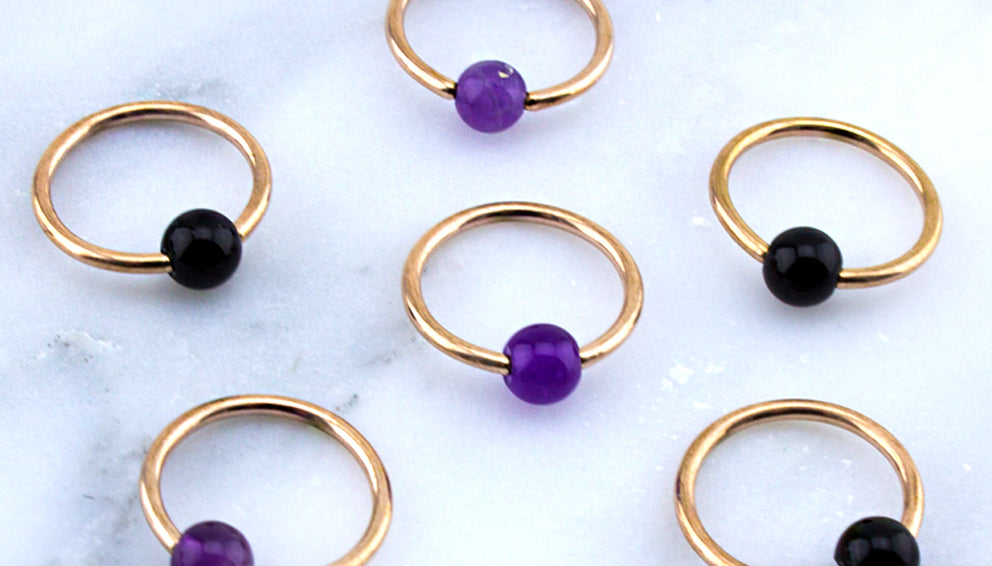Rook Piercing Explained: How it Can Upgrade Your Body Art Game
The highlight of ear cartilage piercings is that there are no shortage of options. With so many natural folds and ridges that make up the ear, piercing the cartilage has become incredibly popular, especially in the last decade.
One unique cartilage piercing that comes to mind is the rook piercing. Located towards the inner cartilage of the ear, the rook is both a versatile and stylish way to upgrade your body art game. Its location is easy to see and can accommodate several jewelry styles to match your style to a tee.
When it comes to getting a new piercing, it’s always important to consider how it will impact your vibe as a whole. Should you keep the jewelry minimal? Or can you let loose with a fun color, gem stone, or shape?
In this blog, we’ll discuss the rook piercing, some jewelry options that can enhance the look and feel of this popular cartilage piercing, and other piercing considerations.
Understanding Rook Piercings
As mentioned previously, the rook is part of your ear cartilage. It’s pierced vertically through a ridge of cartilage in the outer ear, above the tragus in the “anti-helix” area.
Typically, all ear anatomies can accommodate a rook piercing, but talk with your professional piercer if you’re worried about the fit.
The healing process for a rook piercing is anywhere from 6 months to 1 year.

This timeframe accounts for both primary and secondary healing processes, during which you should try to keep the jewelry as stationary as possible. This will help avoid any complications like bleeding, swelling, and/or irritation that could cause you to remove the jewelry for good.
Rook Piercing Jewelry Options
For your starter jewelry, your piercer will probably choose a 16-gauge curved barbell that is 5/16” in length. Curved barbells suit the rook well, showing the ball on either side of the piercing.
For the rook, there are three primary jewelry types: a curved barbell, a captive bead ring, or a hinged segment ring (aka “clickers”).
Curved Barbell
This jewelry type is most common for rook piercings. Seeing both “ends” of the barbell creates a a ton of quirky, eye-catching options to choose from once your piercing is fully healed.
For example, this flower bead CZ internally threaded titanium curved barbell is great for someone who often gravitates towards gems or unusual jewelry shapes.

Captive Bead Ring
The style of a captive bead ring (CBR) is unique because it’s a continuous circle with a ball in the middle for installation and removal.
In the case of CBRs, the “ball” in the middle can take on many different shapes and styles. This stainless steel amethyst stone rose gold PVD captive bead ring puts a spin on the classic CBR by using a bright-colored gemstone against gorgeous gold plating.

Hinged Segment Clicker Ring
Clickers are the most similar to CBRs in that they are continuous hoops. The difference with a clicker is that it opens through a tiny hing and clicks into place seamlessly. These are a great option for those who rock a minimal style.
A great example of how clickers can be unique and minimal at the same time is this star titanium hinged segment ring. Without being too bulky, this jewelry provides an effort celestial vibe.

Tips For Jewelry Selection and Placement
There are a couple considerations when choosing rook piercing jewelry.
First, consider the type of metal your jewelry is made of. If it’s titanium, that’s great because it’s lightweight and super strong. And, it’s biocompatible with your body, meaning that it won’t harm the tissue around the jewelry. This promotes a better healing process overall.
Metals like stainless steel and high-quality gold are other good options. However, both have the potential to be mixed with other alloys than can cause irritation (copper, nickel, etc.).
If you have a known metal allergy, or just have sensitive skin, it’s best to avoid these and go right for titanium.
Next, thinking about the size of your jewelry. For hoop-style jewelry, you don’t want something too snug, because it can cause strain to the piercing site, making it sore.
For a curved barbell, length is key, because it’s atypical to go up or down in gague size. If the jewelry is too long for your rook, it could look awkward and snag on your hair or clothes.
Preparing for a Rook Piercing
First and foremost, it’s crucial to find a reputable piercing studio. Preferably, you should find a studio with professional piercers who have executed a rook piercing before. This due diligence will ensure your health and safety. Once you’ve located a piercing studio, don’t hesitate to ask for a consultation with a piercer before you commit to an appointment (or walking in, if they do that). Let them see your ear to make sure the piercing will suit you and your needs.
After the Piercing
The importance of rook aftercare can’t be overstated. During that 6 months to 1 year healing time, try your best not to touch the piercing outside of cleaning it. Don’t twist the jewelry or otherwise move it to avoid irritation or swelling.
You should also avoid submerging the piercing in any public body of water like pools, hot tubs, lakes, oceans, and the like. These places can introduce bacteria into your fresh piercing, causing an infection.
When it comes to cleaning the piercing, a simple saline wound wash (found at your local pharmacy or piercing studio) will do the trick.
Avoid any antibiotic creams or harsh chemicals like isopropyl alcohol or hydrogen peroxide. While ointments can trap debris and suffocate your piercing, harsh chemicals can dry out the area, cause swelling and/or redness, and worst of all, prolong healing.
The rook piercing lends itself to jewelry artistry. Its placement is perfectly visible to accommodate the most exciting, unique jewelry that not only enhances your personal style, but is comfortable to wear, too.
If you’re in the market for rook jewelry, Urban Body Jewelry has the wide portfolio you need to find jewelry that aligns with any individual’s style.


